MONARCHS REMAIN KINGSWhen Coach Jim Sypult took the job at Methodist College, there was no place to go but up.By Kim Goss Published: Spring 1998 Don’t even think about inferring that the Methodist Monarchs, a Division 3 football team in North Carolina, are a bunch of delicate butterflies. The Monarchs are kings, and the lion is their mighty mascot. Those who question the team’s sovereign position have only to look at the record books and the team’s regal 9-1 season last year. Of course, there was a time. In 1992 when Jim Sypult took over the position as head football coach at the college, he inherited a 2-28 record. While not a bunch of flighty insects, the team was playing more like a den of cubs than the king of beasts. A college coach for 26 years, Sypult saw his path clearly delineated. The team had only been formed in 1989, so growing pains were to be expected. After finishing his first year at 0-10, it was obvious that his team needed to grow up fast. And they did. The following season they improved to 4-6, then 5-5, 6-4, and now 9-1 with a national ranking of number 20. Although their 9-1 record didn’t get them into the playoffs, it’s obvious that the Methodist Monarchs are finally living up to their mascot’s image as king of the jungle. How did Coach Sypult turn things around? With a solid and systematic approach, one step at a time, as he explains to BFS readers in this insightful interview. BFS: Did you have a difficult time motivating your players when you took over the program at Methodist College? JS: When I came aboard, the team had an unfortunate image on campus and in the community as being a doormat. We steadily overcame it through a lot of hard work and a positive attitude. BFS: Was it difficult to recruit good athletes when you took over? JS: The year I took the job I got in late, so I didn’t have a great recruiting class. When I had a full year to recruit I was able to bring in a group that ultimately gave us our first winning season. BFS: What goals did you establish for the team when you began? JS: At first it was a numbers game—winning two games in a row was an objective, and winning a game on the road was an objective. When we got to the point where we were 6-4, we were just points away from being 9-1. That’s when we got away from the numbers and our goal was to play the best football possible and take it one game at a time. BFS: How would you sum up this year in terms of accomplishing your objectives? JS: We had a magical year being 9-1. I say that because in six of those victories we came from behind to win, and two of them were overtime games. So, it was obvious that our players believed in themselves and proved that they could go the distance in the fourth quarter and win. BFS: Your one loss was to Ferrum College, 31-12. What happened? JS: We just had a bad day. The next week Ferrum played Frostburg State University and lost 30-0, and the following week we played our last game of the season against Frostburg. This was a team we had never beaten and we ended up winning 40-12, so we felt like we had rectified that loss. BFS: Now that you’re 9-1, what goals are you setting for the team? JS: That’s an interesting question, because here we are 9-1, so just what do you put up in the locker room to motivate your players? I’ve approached it as being at the crossroads, following in the footsteps of either the Carolina Panthers or the Green Bay Packers. We can be a flash in the pan and drop back into the middle, or we can stay on top. But to answer your question, now our objectives are to be ranked nationally and to be respected nationally. BFS: Is there any fear of losing focus or creating “prima donnas”? JS: One of our standards is that the team is first, the team is everything. We make a contract with each player that all personal glory will come because the team does well. Every guy on our team is 9-1. Every guy on our team feels good, whether he is a starter or a backup or a guy on the bench. Individual honors come about only when someone else selects them. BFS: Since your school doesn’t offer scholarships, how do you attract good athletes? JS: We make our living off the guy who might be an inch or two too short, or a step or two too slow, to get a scholarship. Also, it should be recognized that there are a lot of good football players who want to play college ball but who are not offered scholarships. We try to contact every high school and every prospect in the entire state, even if they are going to be offered scholarships. Because, the fact is, some of those guys are overlooked on national letter days, and we’re the school that’s been talking to them. It’s also the visit that makes the difference—we’re friendly, we offer an opportunity to come to a small school and get a lot of individual attention, and we have a beautiful campus and a multimillion-dollar athletic complex. At Methodist College we go out to meet the clientele, and a lot of them are people just like me. I’m from the coal mines of West Virginia, and these guys are from the cotton mills and the tobacco farms, and most of them are first-generation students—so we get some kids who are at risk academically. Once they get here, we try to work with them. We’ve had many success stories of kids who were not that great in the classroom in high school, but who managed to stay in college. Here, our first priority is to get a degree, and then to play football at its highest level. BFS: Has your emphasis on education benefitted your football team? JS: That’s how we got better as a football team—we kept our kids in school. I remember back when we started we had only one senior on our squad; now we have classes of 12-14 and the numbers are growing every year. I think when it gets to the point where we have 20-25 seniors in the program, we can feel optimistic that we can be a strong force every year. BFS: Are there any other advantages to going to a small college? JS: In a Division 3 school there is room and time for players to be many things at the college. They can come here to play ball, get an education, and still enjoy the benefits that college life affords them. Our team captain, Leon Clark, was student body president. We’ve had players who have been editor-in-chief of the school newspaper or involved in student government. And many are dorm advisors, which is a huge responsibility. BFS: What about the idea that going to a bigger school would increase an athlete’s chances of playing professional football—how do you respond to that argument? JS: When I recruit I emphasis that, by and large, it’s four years of football and then it’s over. And when those four years are over, you’d better have a degree because the likelihood of going on to play professionally is very remote. Besides, if you’re good enough, even at this level, the pros will know about it. BFS: Is it true that at a smaller school players have the advantage of getting more playing time to perfect their football skills? JS: The opportunity to play is greater here. Of course, when I first started, I could say very honestly to a recruit that he could come in and play a lot of football his first year. But, now that we have veterans around, most guys still have to sit out a year in order to get on the field. BFS: Do you “red shirt” players? JS: We don’t use the term “red shirt” in Division 3. In the other divisions, once you start your football career you have five years to play four; in Division 3 you have ten semesters to play four years. An athlete could come to our school for one semester, go into the Army for four years, then come back to school and still have nine semesters left to play four years. BFS: Tell us about your football coaching philosophy. Do you tend to put your best athletes on defense, for example? JS: I don’t think you should necessarily put all your best athletes on defense. For sure we must have a quarterback, a wide receiver and |
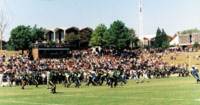 |
|
Methodist Stadium. All Photos By Scott Galayde |
 |
|
Methodist College Campus |
 |
|
|
 |
|
Jim Sypult Methodist University Head Football Coach. |
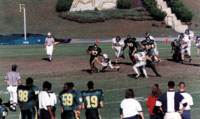 |
|
Tailback Eric Ottey carries the ball around the end in a |
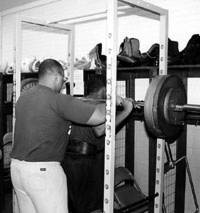 |
|
Defensive Line Coach Eric Westerfield, spotting Trayfer Monroe. |
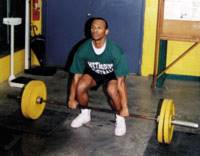 |
|
Trayfer Monroe, a strong safety, was a first team All American and a two-time defensive MVP increased his Power Clean by 30 pounds with BFS in one year. |
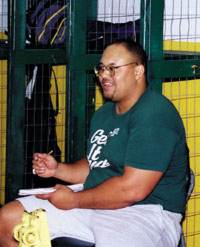 |
|
Monarch Defensive Line Coach Eric Westerfield. |
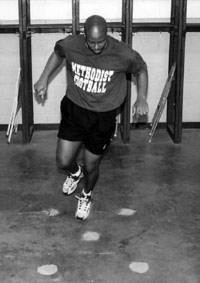 |
|
Darrien Tucker doing the BFS Dot Drill. An excellent warm-up agility drill that’s quick, easy and works great. |